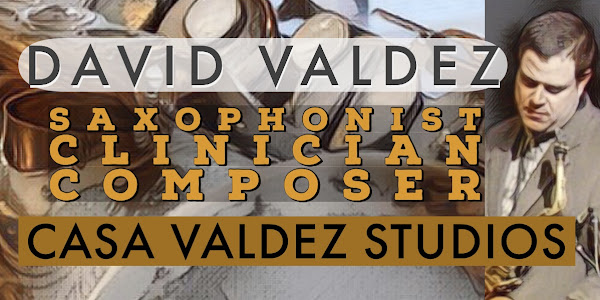Last week I attended the Jazz Education Network convention in Atlanta. I presented a panel on Jazz blogging with Earl MacDonald and George Colligan and saw a lot of great clinics and concerts. It was quite educational and entertaining. I plan to post more details about some of the things (mouthpieces, software, books, bands, ect) that I saw at the JEN convention, so stay tuned.
 |
| Paul Contos |
One of the coolest things about the trip for me was being able to reconnect with my first saxophone teacher Paul Contos, who I hadn't seen in years. I started studying with Paul in seventh grade and studied with him all the up until my freshman year of college, seven years total. He got me started on the Omnibook immediately. We were talking about that last week and Paul said that his strategy was just not to tell his students that it was hard! I started with Bloomdido and eventually learned every note in that book.
Paul is responsible for inspiring a multitude of young musicians to become great Jazz musicians. He recently took over the job of education director for the Monterey Jazz Festival's educational program, which is a huge job because it includes the year round Monterey schools programs, the summer camp, the National Next Gen honor Jazz band, and the Next Gen yearly competition. Paul also runs the
San Francisco Jazz Festival's educational program, which includes an honor band as well. Paul also takes the Next Gen band to Japan or across the US and Canada each year. I recently found a Facebook group called
Paul Contos Changed My Life, which just shows how big of an impact he has had as an educator.
Paul and I had a chance to catch up and then we both went over to
Rafael Navarro's both to try out his pieces, which we had both been hearing a lot about recently. Paul tried the
soprano pieces and I played a few alto pieces. We were both hugely impressed with the work that
Rafy was doing. The soprano piece that Paul tried seemed like a big step up from the Selmer S80 E that he had been using for years. The core was fat and it put out a ton of sound. I'm planning a full review of the alto pieces that I tried and have asked Rafy to do an interview for this blog. I'll also be adding a banner ad for Navarro mouthpieces very soon. It is worth noting that I only post ads for products that I personally use or recommend to my own students.
 |
| Dave Leibman |
Paul is so well know as an educator that I think people often overlook the fact that he a burning and unique player as well. He got swept up in the NY tenor wave back in the late 70's and early 80's, but instead of gravitating to Brecker or Grossman, like many saxophonists, he was more drawn to Liebman. Paul has always been very serious about soprano and flute, making Leibman all the more compelling. Paul mentioned that Leibman was the 'underdog' compared to his contemporaries.
The last time I saw Leib was in the late 90's at the Blue Note. I have got to say that I was a bit disappointed. He played a lot of tenor and I wasn't digging his sound or time concepts. The high point of the night for me was his bamboo flute playing. The last performance I saw at JEN last week was the Miami big band with Leibman and it just blew me away. The big band was truly impressive, tighter than any band that I remember playing with at Berklee, but Dave sounded incredible. He played only soprano and his sound was gorgeous. His harmonic and rhythmic concept was killing....so killing. It made a huge impression on me, making me want to get a better idea of what he was doing. As soon as I got home I ordered the Aebersold published Leibman book
How to Approach Standards Chromatically- techniques of superimposition.
Paul just emailed me some exercises and etudes that he had written for his students. Paul has always had a very cool approach to utilizing fourths in his playing, something which I never incorporated into my playing much so I was happy to get these new exercises. Playing through these etudes made me make a mental note to hit Paul up for another lesson the next time I'm in the Bay Area. I am sure you will enjoy this stuff.
Here is Paul's explanations for his exercises:
"World of Fourths - first is a Preparatory sheet, to get people into maneuvering around the horn in that way, especially if they've been so 'scale-oriented'...and/or just comfortable w/chord-like maj. & min. 3rd diatonic intervals...breaks them out of that.
Next is World of Fourths part. A, which shows a pattern that can be used on at least 5 or 6 chords...(same can be used on: D7sus; A-7;F maj7; Bb maj7#11; C6/9; others)
Next up in an exercise of a chorus of "All The Things" using the World of Fourths concept, moving thru the changes, w/logical transitions & many 1/2step resolutions, as relates to the how things lay nicely on the horn.
Next is an Ex. of a chorus on "Cherokee" - just straight-ahead at first, to help students get into making some smooth linear movements thru the changes, then the last 'A' section starts utilizing some of the Fourth concept thru the changes…It's also the 1st Alto part of a quartet version of that chorus of Cherokee…w/Super-sax type harmony"
World of Fourths PDFs
 |
| (click above for a larger version) |
 |
| (click above for a larger version) |
 |
| (click above for a larger version) |
 |
| (click above for a larger version) |
 |
| (click above for a larger version) |



















